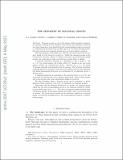The geometry of diagonal groups
Abstract
Diagonal groups are one of the classes of finite primitive permutation groups occurring in the conclusion of the O'Nan-Scott theorem. Several of the other classes have been described as the automorphism groups of geometric or combinatorial structures such as affine spaces or Cartesian decompositions, but such structures for diagonal groups have not been studied in general. The main purpose of this paper is to describe and characterise such structures, which we call diagonal semilattices. Unlike the diagonal groups in the O'Nan-Scott theorem, which are defined over finite characteristically simple groups, our construction works over arbitrary groups, finite or infinite. A diagonal semilattice depends on a dimension m and a group T. For m=2, it is a Latin square, the Cayley table of T, though in fact any Latin square satisfies our combinatorial axioms. However, for m≥3, the group T emerges naturally and uniquely from the axioms. (The situation somewhat resembles projective geometry, where projective planes exist in great profusion but higher-dimensional structures are coordinatised by an algebraic object, a division ring.) A diagonal semilattice is contained in the partition lattice on a set Ω, and we provide an introduction to the calculus of partitions. Many of the concepts and constructions come from experimental design in statistics. We also determine when a diagonal group can be primitive, or quasiprimitive (these conditions turn out to be equivalent for diagonal groups). Associated with the diagonal semilattice is a graph, the diagonal graph, which has the same automorphism group as the diagonal semilattice except in four small cases with m<=3. The class of diagonal graphs includes some well-known families, Latin-square graphs and folded cubes, and is potentially of interest. We obtain partial results on the chromatic number of a diagonal graph, and mention an application to the synchronization property of permutation groups.
Citation
Bailey , R A , Cameron , P J , Praeger , C E & Schneider , C 2022 , ' The geometry of diagonal groups ' , Transactions of the American Mathematical Society , vol. 375 , no. 8 , pp. 5259-5311 . https://doi.org/10.1090/tran/8507
Publication
Transactions of the American Mathematical Society
Status
Peer reviewed
ISSN
0002-9947Type
Journal article
Description
Part of the work was done while the authors were visiting the South China University of Science and Technology (SUSTech), Shenzhen, in 2018, and we are grateful (in particular to Professor Cai Heng Li) for the hospitality that we received.The authors would like to thank the Isaac Newton Institute for Mathematical Sciences, Cambridge, for support and hospitality during the programme Groups, representations and applications: new perspectives (supported by EPSRC grant no.EP/R014604/1), where further work on this paper was undertaken. In particular we acknowledge a Simons Fellowship (Cameron) and a Kirk Distinguished Visiting Fellowship (Praeger) during this programme. Schneider thanks the Centre for the Mathematics of Symmetry and Computation of The University of Western Australia and Australian Research Council Discovery Grant DP160102323 for hosting his visit in 2017 and acknowledges the support of the CNPq projects Produtividade em Pesquisa (project no.: 308212/2019-3) and Universal (project no.:421624/2018-3).Collections
Items in the St Andrews Research Repository are protected by copyright, with all rights reserved, unless otherwise indicated.

